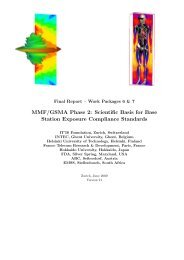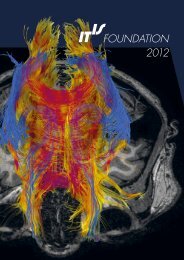Projects
download report
download report
- No tags were found...
You also want an ePaper? Increase the reach of your titles
YUMPU automatically turns print PDFs into web optimized ePapers that Google loves.
.-<br />
I<br />
Electromagnetic<br />
Simulation Platform for<br />
Microsystems and<br />
Wireless Technology<br />
Funds<br />
Swiss Priority Program in Micro & Nano<br />
Systems Technology (SPP MINAST)<br />
Partners<br />
Integrated Systems Laboratory<br />
ISE AG Zurich<br />
SPEAG Zurich<br />
Huber & Suhner AG<br />
Telekom PTI<br />
Background<br />
The accurate modeling of electromagnetic effects, which<br />
in the past was only a matter of academic interest, is<br />
now becoming an increasingly important issue in the<br />
design of advanced commercial microelectronic devices<br />
and systems. The rapidly increasing level of integration<br />
and miniaturization of microelectronic systems requires<br />
exact knowledge on such parasitic effects as cross-talk,<br />
coupling, radiation and irradiation. The accurate simulation<br />
of these electromagnetic effects is necessary to be<br />
able to reliably predict the behavior of microelectronic<br />
systems. Microelectronic systems also either rely on or<br />
have built-in wireless technology features. Miniaturization<br />
and limitation of the power consumption of devices pose<br />
great challenges that can only be mastered by designing<br />
efficient antennas for use in complex environments.<br />
Together with the Integrated Systems Laboratory and<br />
four partners from industry, our group is currently developing<br />
an electromagnetic simulation platform to analyze<br />
and optimize microelectronic systems.<br />
Objectives<br />
The objective of this project is to develop a robust and<br />
flexible platform for electromagnetic computations. The<br />
wide range of applications envisaged requires a hybrid<br />
simulation system that offers several simulation techniques<br />
to perform fullwave, quasi stationary and electrostatic<br />
simulations.<br />
Methods<br />
The platform consists of several computational kernels.<br />
Rigorous electromagnetic fullwave simulations are to be<br />
performed using the Finite-Difference-Time-Domain<br />
(FDTD) Technique. This technique allows the simulation<br />
of complex configurations by way of discretizing space.<br />
Since the computation is performed in the time domain,<br />
signal behavior can be easily simulated. Further kernels<br />
based on the Finite Element Technique and the Generalized<br />
Multipole Technique can be used for specialized<br />
purposes. The integration of all these features into the<br />
same platform allows the use of the same set of preprocesssing,<br />
post-processing and .visualization tools. Data<br />
obtained by the different simulation techniques can be<br />
easily exchanged on the simulation platform, e.g., using<br />
data from a quasi stationary simulation as the excitation<br />
source for a full wave simulation. The integration of<br />
each simulation technique into an optimization loop<br />
enables the structure being investigated to be optimized<br />
with respect to a well characterized set of parameters.<br />
Simulated (top) and measured (bottom) H-field distribution 5 mm<br />
above a generic phone. The measurement was performed with the<br />
near field scanner DASY2 by SPEAG, the simulation was<br />
performed using the FDTD technique.<br />
Results and Discussion<br />
The implementation of the FDTD kernel is in an advanced<br />
stage, allowing the full wave simulation of a wide range<br />
of electromagnetic applications. Its design is fully objectoriented,<br />
allowing further flexible modular development.<br />
Using a near field scanner for experimental verification,<br />
various benchmarking tasks for radiation problems have<br />
been performed together with our industrial partner<br />
SPEAG.<br />
The kernel is currently being integrated into a graphical<br />
user-interface by ISE AG. This tool combines various<br />
discretization, simulation and visualization tools.<br />
12





